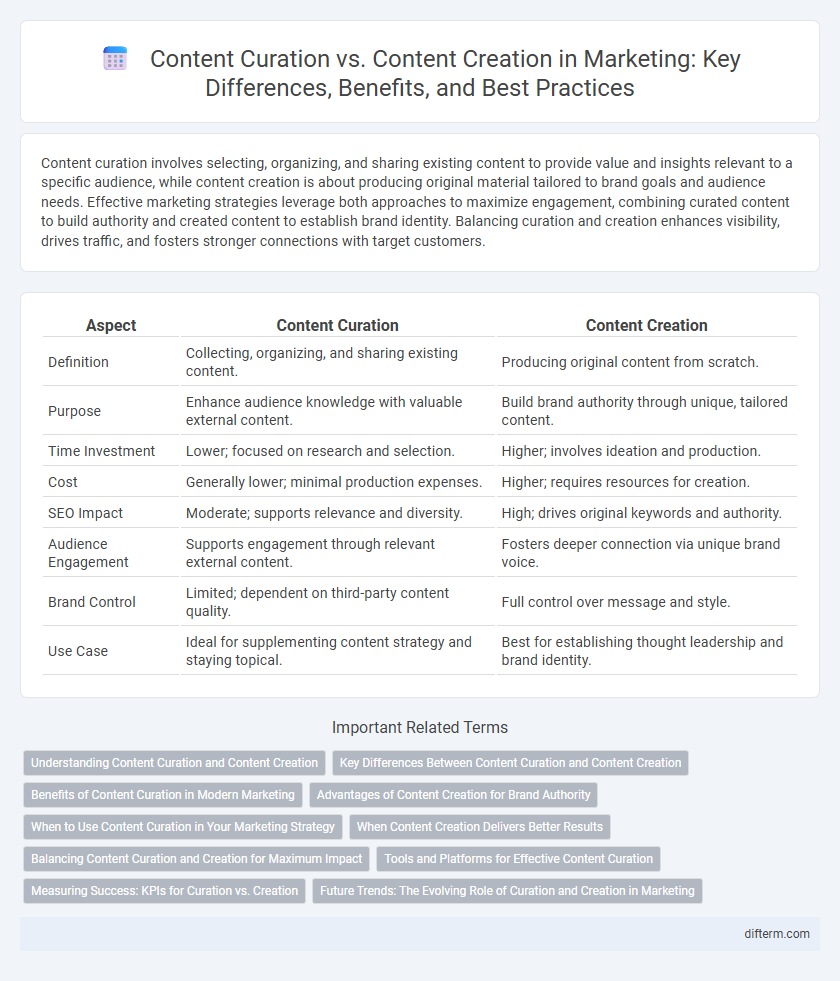Content curation involves selecting, organizing, and sharing existing content to provide value and insights relevant to a specific audience, while content creation is about producing original material tailored to brand goals and audience needs. Effective marketing strategies leverage both approaches to maximize engagement, combining curated content to build authority and created content to establish brand identity. Balancing curation and creation enhances visibility, drives traffic, and fosters stronger connections with target customers.
Table of Comparison
| Aspect | Content Curation | Content Creation |
|---|---|---|
| Definition | Collecting, organizing, and sharing existing content. | Producing original content from scratch. |
| Purpose | Enhance audience knowledge with valuable external content. | Build brand authority through unique, tailored content. |
| Time Investment | Lower; focused on research and selection. | Higher; involves ideation and production. |
| Cost | Generally lower; minimal production expenses. | Higher; requires resources for creation. |
| SEO Impact | Moderate; supports relevance and diversity. | High; drives original keywords and authority. |
| Audience Engagement | Supports engagement through relevant external content. | Fosters deeper connection via unique brand voice. |
| Brand Control | Limited; dependent on third-party content quality. | Full control over message and style. |
| Use Case | Ideal for supplementing content strategy and staying topical. | Best for establishing thought leadership and brand identity. |
Understanding Content Curation and Content Creation
Content curation involves gathering, organizing, and sharing relevant information from various sources to provide value to a target audience, while content creation focuses on producing original and unique material tailored to specific brand goals. Effective content curation enhances audience engagement by presenting diverse perspectives, whereas content creation builds brand authority through authentic storytelling and innovation. Balancing both strategies optimizes content marketing efforts, driving better reach, trust, and conversion rates.
Key Differences Between Content Curation and Content Creation
Content curation involves gathering, organizing, and sharing relevant information from various sources to provide value, while content creation requires producing original material tailored to the target audience's needs. Curation focuses on adding context and perspective to existing content, enhancing credibility and saving time, whereas creation emphasizes innovation and brand storytelling to establish authority and differentiation. Key metrics for content curation include engagement and reach, while content creation prioritizes originality, SEO rankings, and audience growth.
Benefits of Content Curation in Modern Marketing
Content curation enhances modern marketing by streamlining the delivery of relevant, high-quality information to target audiences, fostering trust and engagement without the extensive resources required for original content creation. It enables marketers to stay current with industry trends, amplify brand authority, and maintain consistent online presence through sharing diverse perspectives. Leveraging curated content also accelerates audience growth and nurtures community interactions, driving sustained traffic and improved SEO performance.
Advantages of Content Creation for Brand Authority
Content creation allows brands to produce original, tailored content that directly reflects their values and expertise, enhancing brand authority in their niche. By consistently generating unique content, brands can improve search engine rankings and foster a loyal audience through authentic engagement. This strategic approach positions companies as industry leaders, driving trust and long-term customer relationships.
When to Use Content Curation in Your Marketing Strategy
Content curation is most effective in marketing when brands need to maintain consistent audience engagement without the resource intensity of constant original content production. It works well for sharing industry insights, enhancing brand authority, and supplementing content calendars with relevant third-party materials. Integrating curated content helps marketers fill gaps during product launches, seasonal campaigns, or when testing new content formats, ensuring continuous value delivery.
When Content Creation Delivers Better Results
Content creation delivers better results when brands require unique, tailored messages that resonate deeply with target audiences and drive stronger engagement. Original content enhances SEO performance by incorporating relevant keywords and offers the flexibility to address specific customer pain points directly. In competitive markets, fresh, authentic content establishes brand authority and fosters long-term customer loyalty more effectively than curated materials.
Balancing Content Curation and Creation for Maximum Impact
Balancing content curation and content creation enhances marketing strategies by combining curated industry insights with original brand storytelling, driving engagement and authority. Effective content curation leverages third-party resources to maintain consistent posting schedules while original content creation differentiates the brand with unique perspectives and value propositions. Integrating both approaches maximizes audience reach, SEO performance, and nurtures customer trust across digital platforms.
Tools and Platforms for Effective Content Curation
Effective content curation relies on specialized tools and platforms such as Feedly, Pocket, and Curata, which streamline the discovery, organization, and sharing of relevant industry content. These platforms use AI-driven algorithms to filter and recommend articles, videos, and social media posts, enhancing the efficiency of marketers in maintaining a consistent content flow. Integrating tools like Buffer or Hootsuite allows seamless scheduling and distribution, maximizing audience engagement through curated content.
Measuring Success: KPIs for Curation vs. Creation
Measuring success in content curation versus content creation involves distinct KPIs tailored to each approach; for curation, engagement metrics such as shares, comments, and click-through rates highlight audience interaction with curated materials. In contrast, KPIs for content creation emphasize original content performance, including organic reach, on-site time, and conversion rates driven by unique messaging. Both strategies rely on tracking lead generation and brand awareness, but content creation demands deeper analytics on content originality and audience retention.
Future Trends: The Evolving Role of Curation and Creation in Marketing
Content curation and content creation are converging in marketing as AI-driven tools enable more personalized and dynamic audience engagement. Future trends emphasize the integration of curated content with original creations to enhance brand storytelling and improve data-driven decision-making. Marketers increasingly rely on real-time analytics to balance curated insights with innovative content, optimizing customer experience across platforms.
Content Curation vs Content Creation Infographic

 difterm.com
difterm.com